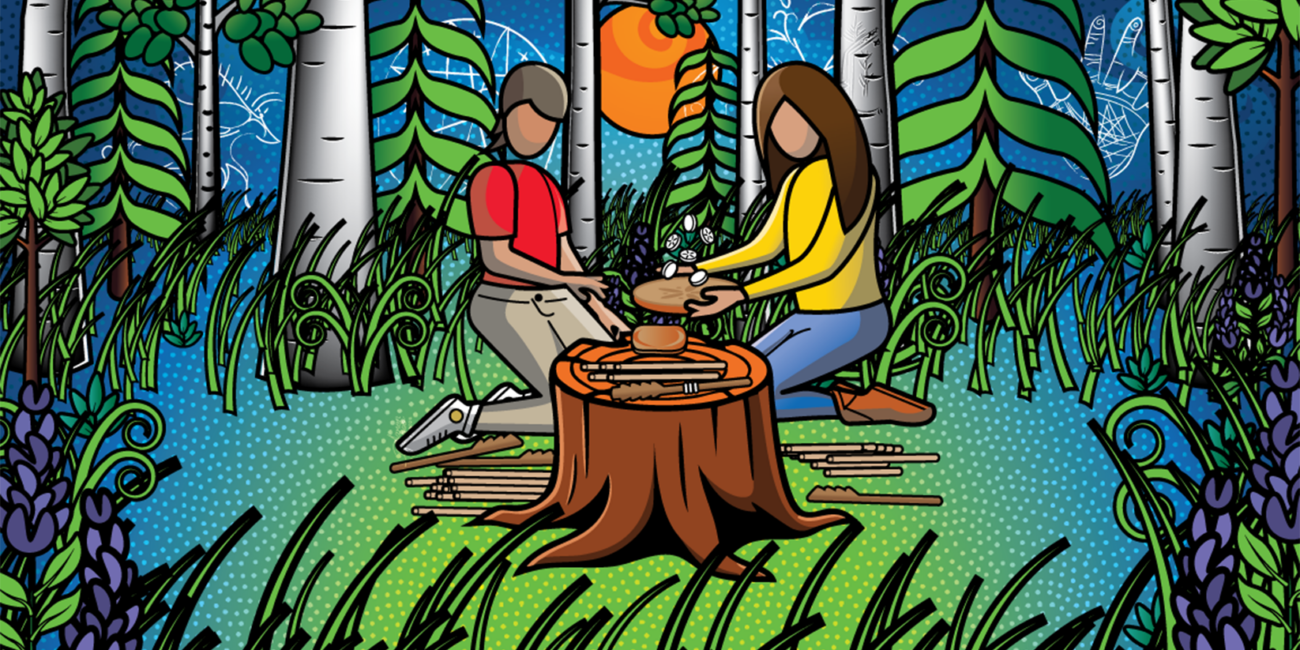Once, an old man and an old woman prayed for a child. Their prayers were finally answered, and they were blessed with a baby boy. They loved him dearly and taught him all they knew. But one day, their son fell ill and passed away. The old man mourned deeply, gathered other men and embarked on a journey to the Land of Souls to bring his son back.
After many moons, the old man and his companions reached the gate to the Land of Souls. The gatekeeper, moved by the old man’s love for his son, offered him a chance: “If you can beat me at Waltes, I’ll allow you to bring your son’s spirit back home.”
And so began Waltes, a traditional Mi'kmaw game of chance passed down through generations for over 500 years. According to legend, the game was so much fun, and the dice landed with such a loud thud that the vibrations travelled to the spirit world, capturing their attention and earning their favour for this captivating game.
What is Waltes?
Waltes is more than just a game; it’s a piece of Mi’kmaw culture, history, and art. Played with two to four players at a time, it’s a fun game of chance that can last minutes, hours, or even days. The game hones counting skills, and the goal is to score points based on how the dice land on each turn. Each dice represents a different Mi’kmaw worldview that we live in:
- Lampqamuk (The Underground World): Representing the spirits buried beneath us.
- Kimitknaq (The Earth World): The place where we were born.
- Muskun (The Sky World): Where the sun, moon, clouds and stars reside.
- Mestawu’lk (The Universe World): Encompassing everything that exists.
- Lampok (The Water World): Representing rivers, lakes, and oceans.
- Jijaqamijue’kati (The Spirit World): A sacred realm where spirits dwell.
The Waltes bowl symbolizes the seventh world, Muskopi (The Womb of Mother Earth), where all these worlds come together and rest.
What do You Need to Play Waltes?
- A hardwood bowl (30 cm in diameter, 3 cm deep)
- Six disc-shaped dice, traditionally carved from moose or deer bone, with one side rounded and the other flat, featuring a Mi’kmaw symbol engraved on the flat side
- A total of 55 scoring sticks:
-
- 1 Old Man (notched on both sides)
- 3 Old Women (notched on one side)
- 51 plain sticks (3 sticks equal 1 point)
-
- A counter (a person who keeps track of points)
- A blanket or fur
- Bring your humour, language, and thinking skills

How to Play Waltes
- Players sit opposite each other, with the bowl on a folded blanket or fur between them, usually sitting on the floor to honour their ancestors or on a custom-made Waltes bench.
- It’s customary for each player to introduce themselves by name, where they are from, and share their family clan name (or last name).
- Place the six dice in the bowl with the marked faces down. Pick them up with one hand and roll them back into the bowl to determine which player will take the first turn. The player who rolls the most symbols face-up (showing the design) gains the advantage of the first play.
- Now, you want to make the dice dance to begin the game. The first player holds the bowl with both hands, lifts it 8-10 cm above the blanket or fur, and slams it down with a controlled yet firm motion, flipping the dice until they land to score points.
- As your dice dance, wave your hand on top of the bowl. This gesture, called “A’ma,” is for good luck. It’s believed to persuade the dice to land in a way that scores points.
- The goal of the game is to collect points. Scoring is determined by how the dice land in the bowl each turn.
-
-
- A counter must be present.
- If all dice land showing the design (or vice versa, all landing with the white side up), the player is rewarded with an Old Lady (5 points) and another turn. Three Old Ladies must be won before the Old Man (10 points) can be given.
- The Old Ladies can also be won through a combination of points, but the Old Man must be won only after the Old Ladies have been rewarded by all dice landing either up or down. Your opponent has one chance to win the Old Man back with the same move. If they win him back, they automatically receive payment, and they can flip the Waltes bowl and ask for payment immediately to win the game.
- If all but one dice is facing up and five other dice are facing down (or vice versa), 1 point is scored (3 sticks equal to 1 point), plus you get another turn.
- If you score this twice in a row, you are rewarded with 3 points, which equals 9 sticks.
- If you score this three times in a row, an Old Lady is rewarded (5 points).
- All other combinations of dice landing (e.g., 3 up | 3 down, 4 up | 2 down, or vice versa) yield no points.
- The more times you successfully flip the dice accordingly, the more points you can score.
- Players alternate turns with varying counting methods, adding excitement to the game!
- Once all sticks are given out, the person with the most points wins!
-
The game’s dynamic nature makes it truly exciting! Share laughs, cheers, and playful teasing as the points add up.
Note: This game has many stages; these instructions are focused on the first one.
Why Play Waltes?
Waltes is not just about winning; it’s about connecting with Mi’kmaw heritage, culture, storytelling, and language and enjoying quality time together. It’s a way to honour the past and celebrate the present! Gather your friends and family and let the spirit of friendly competition guide you.
Can't Wait to Play it?
Head over to Sipekne’katik Treaty Truckhouse, a shop on the Halifax Waterfront that offers hand-crafted Indigenous items, including the Waltes game. Enjoy the magic of this beloved Mi’kmaw tradition!

Special thanks to NSITE’N, Sunshine Paul-Martin, and Sipekne’katik Treaty Truckhouse for their support in the creation of this content.
Illustration by Aaron Googoo.


